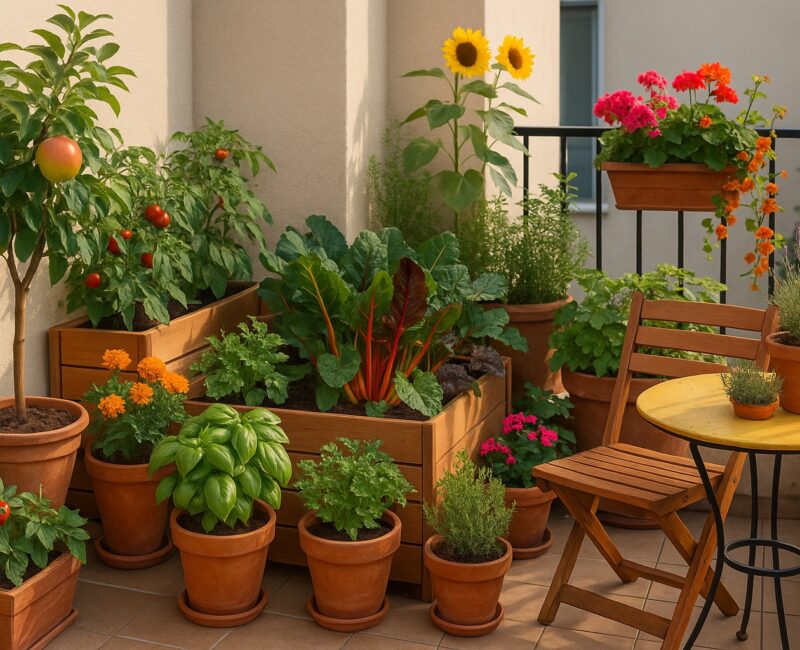The Rise of Edible Landscapes
In 2025, one of the most exciting gardening movements is the rise of urban edible landscapes. These gardens blur the line between ornamental and functional by combining beautiful plants with food-producing species.
Imagine walking into a garden where roses climb alongside beans, lavender borders a tomato patch, and fruit trees line a city courtyard. It’s practical, sustainable, and visually stunning.
Read more – Balcony Gardening: How to Grow Edible Plants in Apartments
For urban gardeners in the US and Europe, edible landscapes are more than just a trend—they are a solution to limited space, rising food costs, and the desire to reconnect with nature.
What Is an Edible Landscape?
An edible landscape is a designed garden space that integrates food crops with ornamental plants. Instead of separating vegetables into utilitarian beds and flowers into decorative borders, both coexist in harmony.
This style can take many forms:
- A balcony with herbs mixed with marigolds.
- A front yard with blueberry bushes instead of boxwood.
- A city park filled with fruit trees.
The goal is to create a space that is beautiful, functional, and sustainable.
Benefits of Urban Edible Landscapes
1. Dual Purpose Beauty
Every plant in an edible landscape is chosen for looks and function—vivid flowers attract pollinators, while vegetables and herbs provide food.
2. Sustainability
Edible landscapes reduce food miles, chemical inputs, and reliance on industrial farming.
3. Better Nutrition
Growing your own herbs, fruits, and vegetables provides fresh, nutrient-dense produce.
4. Pollinator Support
Flowering herbs and food crops create habitats for bees, butterflies, and beneficial insects.
5. Economic Value
A productive edible landscape can offset grocery bills while increasing property value.
Design Principles of Edible Landscaping
To create a successful edible landscape, follow these guiding principles:
1. Right Plant, Right Place
Match plants to sunlight, soil, and climate conditions.
2. Layering & Diversity
Use tall fruit trees, mid-level shrubs, groundcover herbs, and vertical climbers for a lush effect.
3. Aesthetic Integration
Combine color, texture, and seasonal interest. For example: pair kale with ornamental cabbage or nasturtiums with cucumbers.
4. Continuous Harvest
Stagger plantings for year-round beauty and food supply.
5. Eco-Friendly Practices
Use composting, mulching, and rainwater harvesting to keep maintenance low and sustainable.
Best Plants for Urban Edible Landscapes
Here are some top plant picks for US and European gardeners:
Fruit Trees & Shrubs
- US Options: Apple, Peach, Blueberry, Raspberry.
- European Options: Plum, Pear, Currants, Gooseberry.
- Universal Picks: Fig, Olive (mild climates), Dwarf citrus trees.
Herbs & Edible Flowers
- Basil, Rosemary, Thyme, Oregano.
- Lavender (ornamental + culinary).
- Nasturtiums, Calendula, Chamomile.
Vegetables with Ornamental Value
- Swiss Chard – Bright rainbow stems.
- Purple Kale – Decorative and nutrient-rich.
- Tomatoes – Glossy fruits with vibrant growth.
- Peppers – Compact, colorful, and productive.
Vines & Climbers
- Grapevines.
- Pole Beans.
- Passionfruit.
These plants combine productivity with aesthetic appeal, making them perfect for urban edible landscaping.
Edible Landscapes in Small Urban Spaces
1. Balconies
- Use vertical planters for strawberries, spinach, and herbs.
- Mix flowering plants like marigolds with tomatoes to repel pests.
2. Courtyards
- Dwarf fruit trees in containers.
- Raised beds with a mix of flowers and leafy greens.
3. Rooftops
- Install container gardens with peppers, kale, and basil.
- Add trellises for beans or cucumbers.
4. Front Yards
- Replace ornamental hedges with blueberry bushes.
- Swap grass lawns for clover and herb groundcovers.
How to Start Your Urban Edible Landscape
Step 1: Assess Your Space
Check sunlight hours, available containers, and soil conditions.
Step 2: Plan for Beauty + Food
Sketch out a design mixing vegetables, herbs, flowers, and trees.
Step 3: Prepare the Soil or Containers
Use compost-rich soil for maximum productivity.
Step 4: Plant in Layers
- Trees/shrubs at the back.
- Mid-level vegetables in the center.
- Groundcovers and herbs at the edges.
Step 5: Maintain Naturally
Water efficiently (drip irrigation), compost, and rotate crops for soil health.
Companion Planting in Edible Landscapes
Companion planting is key to healthy edible landscapes. Examples include:
- Tomatoes + Basil – Improves flavor and repels pests.
- Cabbage + Nasturtiums – Trap pests away from crops.
- Beans + Corn – Beans fix nitrogen, corn provides support.
- Lavender + Fruit Trees – Attracts pollinators, deters moths.
This makes your garden not only more productive but also naturally pest-resistant.
Common Mistakes to Avoid
- Overcrowding: Plants need breathing room for growth and airflow.
- Ignoring Seasonality: Choose crops suited to your climate.
- Neglecting Aesthetics: Balance food crops with ornamental plants for visual appeal.
- Using Chemicals: Stick to organic methods to protect pollinators and soil health.
Climate-Friendly Edible Landscapes
Urban edible landscapes are also tools for climate resilience:
- Shade trees reduce heat islands.
- Rain gardens manage stormwater runoff.
- Clover and herbs reduce irrigation needs.
- Perennials like fruit trees store carbon for decades.
By choosing climate-friendly designs, your landscape becomes both productive and protective.
Design Inspirations
- Mediterranean Style: Olive trees, lavender, rosemary, grapevines.
- Cottage Garden Style: Wildflowers mixed with lettuce, kale, and peas.
- Modern Minimalist: Sleek raised beds with ornamental peppers and Swiss chard.
- Community Gardens: Shared fruit trees and colorful vegetable plots.
Why Urban Edible Landscapes Are Here to Stay
Rising food costs, climate change, and shrinking urban spaces are pushing gardeners to think differently. Edible landscapes provide a sustainable answer—feeding families, boosting biodiversity, and beautifying neighborhoods all at once.
This movement reflects a forward-thinking gardening mindset: one where beauty and utility coexist harmoniously.





